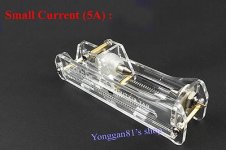Synon
10 W
As someone who wanted to go with the "used laptop battery" route due to having a good source of batteries I recognized how tedious it is individually test the hundreds of cells I have, in fact if I did have to do them one at a time I would have given up a long time ago. So here are some jigs I built to expedite the process, hopefully this will help others who are thinking about doing the same thing. I also like to spend as little money as possible, it seems insane to go out and buy all these little individual chargers.
Of course I owe everything I've learned to this forum and the helpful people here. Special thanks to DrkAngel's posts about testing these, the discharging station is based on his method with the light bulbs.
Here is a list of everything used:
Power supply: old computer power supply
Charger: Thunder 1220
Battery contact plates: http://www.ebay.com/itm/331580267154?rmvSB=true
Some scrap wood, copper wire, light bulbs and a switch
Mass charging
Each of these battery sleds holds 30 cells. One side has the battery contact plates attached with hot glue to the wood, some 10 gauge copper has been soldered along the entire length. The other side is some flat headed screws with copper wire weaved through before the screws were tightened down. When I have a sufficient amount of cells to charge, I sort them by voltage and load the lowest batch first (within .1 volts), charge them until they reach the voltage of the next batch to be loaded... rinse and repeat until all cells are loaded. I usually have both sleds in parallel if I have enough cells. Then it's just a waiting game until everything is charged. A lot of my batteries have 2/3 cells still connected on tabs and I now leave them that way, so I can charge up to 180 cells at a time. Obviously everything is in parallel, take great care in making sure you put the cells in with the correct orientation.

Mass discharge
As mentioned earlier, DrkAngel's post was the inspiration for this. 30 cells in series, I use the same battery contact plates at the ends connected by copper wire and use the same plates in between cells (you can see them scattered around). Sorry I don't have a pic of this thing loaded up, but you get the idea. I test the voltage after loading each "string" of 5 cells to make sure there is contact. When everything is loaded you end up with 120v and two 60watt lightbults discharging the system, each hour equals 1Ah off each cell, nice and easy math. I have a small switch to turn the light on and off. I take measurements off every cell 15 minutes with my multimeter (while the system is discharging), I keep a log of each measurement. Instead of measuring, writing down, measuring, writing down... I use my iphone and just turn on the voice recorder and measure all the cells, then play it back and write it down... much much faster.

Anyway, hopefully this helps others come up with some ideas. If you have your own system share some pictures and tell us how it works!
Of course I owe everything I've learned to this forum and the helpful people here. Special thanks to DrkAngel's posts about testing these, the discharging station is based on his method with the light bulbs.
Here is a list of everything used:
Power supply: old computer power supply
Charger: Thunder 1220
Battery contact plates: http://www.ebay.com/itm/331580267154?rmvSB=true
Some scrap wood, copper wire, light bulbs and a switch
Mass charging
Each of these battery sleds holds 30 cells. One side has the battery contact plates attached with hot glue to the wood, some 10 gauge copper has been soldered along the entire length. The other side is some flat headed screws with copper wire weaved through before the screws were tightened down. When I have a sufficient amount of cells to charge, I sort them by voltage and load the lowest batch first (within .1 volts), charge them until they reach the voltage of the next batch to be loaded... rinse and repeat until all cells are loaded. I usually have both sleds in parallel if I have enough cells. Then it's just a waiting game until everything is charged. A lot of my batteries have 2/3 cells still connected on tabs and I now leave them that way, so I can charge up to 180 cells at a time. Obviously everything is in parallel, take great care in making sure you put the cells in with the correct orientation.

Mass discharge
As mentioned earlier, DrkAngel's post was the inspiration for this. 30 cells in series, I use the same battery contact plates at the ends connected by copper wire and use the same plates in between cells (you can see them scattered around). Sorry I don't have a pic of this thing loaded up, but you get the idea. I test the voltage after loading each "string" of 5 cells to make sure there is contact. When everything is loaded you end up with 120v and two 60watt lightbults discharging the system, each hour equals 1Ah off each cell, nice and easy math. I have a small switch to turn the light on and off. I take measurements off every cell 15 minutes with my multimeter (while the system is discharging), I keep a log of each measurement. Instead of measuring, writing down, measuring, writing down... I use my iphone and just turn on the voice recorder and measure all the cells, then play it back and write it down... much much faster.

Anyway, hopefully this helps others come up with some ideas. If you have your own system share some pictures and tell us how it works!




